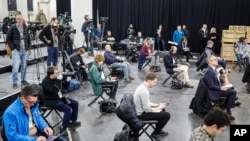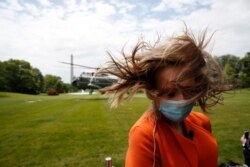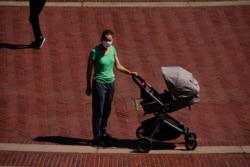Recent research finds that women are more likely than men to produce trustworthy news reports on the COVID-19 pandemic, according to The Factual, a technology company in San Mateo, California, that measures the credibility of hundreds of news outlets.
Phillip Meylan, a political analyst at The Factual, said he began crunching data on coronavirus reporting early in the pandemic and started to notice that many of the top-rated articles had been written by women.
“Why are eight of them female out of 10? And so if you see that once, it's kind of incidental. You think, okay, well, that, you know, it's just random. It's what I chose. But we saw it over and over and over again,” he told VOA.
So he started to look at the data more closely, and he found that women consistently dominated the rankings for COVID-19 reporters, accounting for 19 of the 25 most-trusted journalists and 58 of the top 100.
The figures are even more impressive than they appear, Meylan said, because “female journalists are underrepresented in the total sample.” Male reporters produced nearly 60 percent of the COVID-19 stories reviewed by The Factual over 135 days. A total of 39,084 articles from 167 news outlets were included in the data set.
“When you look at how [women] perform overall in terms of our credibility metric, they top the list and it's really strong,” Meylan said.
The Factual uses an artificial intelligence algorithm to determine credibility, based on the publication’s history of trustworthiness, the author’s work, the sources used and the tone of the story. Anything with a rating of 75 percent or above is considered very credible.
“What those numbers tell us overall is just that, at least when it comes to coronavirus, female journalists have been more neutral in their tone," Meylan said. "They've been better resourced, and they've overall just produced better articles.”
Female reporters tend to score more highly than their male counterparts on other kinds of reporting as well, though not by such a significant margin. But allowing for the fact that they are outnumbered by the men, the number of women in the top ranks “does suggest that female journalists on average are more credible.”
Meylan said the findings did not suggest that “you should go just read female journalists on coronavirus. But we saw it as an inroad to looking at why female journalists are underrepresented when it comes to anywhere in journalism, and how that may be affecting our news quality overall.
“So if female journalists face challenges, face more obstacles, basically, when going out to do stories, whether it's on coronavirus or the recent protests, how is this affecting our news output? And how is it affecting the overall narratives?” he said.
To put the findings into a wider context, The Factual contacted gender equality expert Lucina Di Meco in San Francisco. Di Meco told VOA that in many fields, including journalism and political leadership, women have to be “as prepared or even overprepared to hold the same jobs that men hold, sometimes being paid less for those jobs, and are not afforded any mistakes.”
“So it doesn't surprise me that if we look at issues that are so crucial, women would really be especially careful in their approach, and female journalists in particular would be especially careful in the kind of news that they deliver,” she said.
Different approach to leadership
Di Meco is the author of #ShePersisted, a study of the relationship between women and men in politics and social media globally. She said women take an approach to leadership that is “more participatory, that's more careful, that tries to take into consideration a broader set of stakeholders.
“And those are some of the same skills that are needed for a journalist to really shape a very good story that takes into account all the dimensions. So I definitely see parallels here.”
The Factual’s findings came on the heels of reports that countries led by women have been more successful in fighting the virus. New Zealand, led by Prime Minister Jacinda Arden, had declared the disease eradicated before a handful of recent travelers were found to be infected.
“We know that women in politics tend to be more respected by the public in the sense that there are positive stereotypes associated to them, like their being more honest," Di Meco said. "We know that countries that are led by women or that have higher numbers of women in their national parliaments have better health outcomes, and there are studies around that those countries also tend to be less corrupt.”
Still, she added, “there are entrenched groups of power, male-dominated power groups that have no interest in enabling women to be able to access those powers,” including in journalism.
Greater burden
Despite their credibility on the issue of the coronavirus, Di Meco said, the pandemic is placing a greater burden on women than men, especially in families where both partners are teleworking.
“It has been shown that women, when they're home and their partners are at home, are taking on the majority of the child care," she said. "It has been shown that, for example, in academia, women are now submitting fewer papers than their male colleagues, and that is very much having to do with the fact that they have less time to do their work."
Di Meco said she also had seen some deliberate efforts to deny women leadership roles on COVID-19 — whether in politics or journalism — despite their successes to date.
“The treatment that female politicians receive is very similar to the treatment that female journalists receive," she said. "And that's having to do with the fact that they are public figures.
“And there are some groups of the population and some groups of interest [who] just don't want to see women holding those leadership positions and being thought leaders in our society.”
Di Meco noted that the pandemic was negatively affecting women in other ways as well, including greater job losses and an increase in domestic violence.
She said policymakers have a responsibility to ensure that the needs of women and girls are taken into account in any decisions on how to deal with the effects of the pandemic, including the economic recovery.











